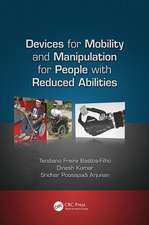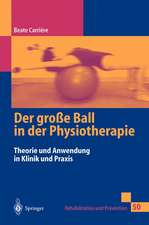The Swiss Ball: Theory, Basic Exercises and Clinical Application
Autor Beate Carrière Cuvânt înainte de V. Janda Contribuţii de R. Tanzbergeren Limba Engleză Paperback – 25 noi 1997
Preț: 376.06 lei
Preț vechi: 395.85 lei
-5% Nou
Puncte Express: 564
Preț estimativ în valută:
71.97€ • 74.86$ • 59.41£
71.97€ • 74.86$ • 59.41£
Carte tipărită la comandă
Livrare economică 14-28 aprilie
Preluare comenzi: 021 569.72.76
Specificații
ISBN-13: 9783540611448
ISBN-10: 3540611444
Pagini: 412
Ilustrații: XXIV, 385 p. 561 illus.
Dimensiuni: 155 x 235 x 22 mm
Greutate: 0.6 kg
Ediția:1998
Editura: Springer Berlin, Heidelberg
Colecția Springer
Locul publicării:Berlin, Heidelberg, Germany
ISBN-10: 3540611444
Pagini: 412
Ilustrații: XXIV, 385 p. 561 illus.
Dimensiuni: 155 x 235 x 22 mm
Greutate: 0.6 kg
Ediția:1998
Editura: Springer Berlin, Heidelberg
Colecția Springer
Locul publicării:Berlin, Heidelberg, Germany
Public țintă
Professional/practitionerCuprins
1 History of the Swiss Ball.- 1.1 Introduction.- 1.2 History of Literature on the Swiss Ball.- References.- 2 Neuroanatomical, Neurophysiological, and Physiological Bases: A Hypothesis.- 2.1 Brain Stem and Reticular Formation.- 2.2 Cerebellum.- 2.3 Vestibular System.- 2.4 Hypothalamus.- 2.5 Thalamus.- 2.6 Basal Ganglia.- 2.7 Autonomic Nervous System.- 2.8 Limbic System.- 2.9 Sensorimotor System.- 2.10 Physiological Responses.- References.- 3 Motor Learning.- 3.1 Stages of Learning.- 3.2 Knowledge of Result, Knowledge of Performance.- 3.3 Feedback.- 3.4 Clinical Applications: Examples.- 3.5 Plasticity of the Brain.- References.- 4 Practical Considerations.- 4.1 Ball Conditions.- 4.2 Safety Conditions.- 4.3 Precautions, Contraindications.- References.- 5 Points of Observation.- 5.1 Ball-Floor.- 5.2 Ball-Body.- 5.3 Body-Floor.- 5.4 Base of Support.- 5.5 Bisecting Plane.- 5.6 Body Distances.- 5.7 Hinged Joints.- 5.8 Continuing Movement and Buttressing.- References.- 6 Exercise Terminologyand Muscle Activity.- 6.1 Exercise Terminology.- 6.2 Variations of Muscle Activity.- 6.3 Primary Movement, Actio-Reactio.- 6.4 Conditio-Limitatio.- References.- 7 Planning of Exercises, Screening, Evaluation, and Treatment.- 7.1 Evaluation.- 7.2 Muscle Strength and Range of Motion.- 7.3 Back Extensor and Trapezius Muscles: Testing Strength.- 7.4 Triceps Brachii Muscle: Testing Strength.- 7.5 Abdominal Muscles and Hip Flexor Muscles (Iliopsoas): Testing Strength in Sitting Position.- 7.6 Evaluating Alignment.- 7.7 Evaluating Quality of Movement and Dissociation of the Lower Extremities.- 7.8 Testing Balance.- 7.9 Identifying Neurotension Problems and Treatment.- References.- 8 Assistive Devices.- 8.1 Sitfit and Swiss Ball.- 8.2 Foam Roll and Swiss Ball.- 8.3 Swiss Ball and Thera-Band.- 8.4 Swiss Ball and Dumbbells.- 8.5 Swiss Ball as an Assistive Device in Manual Therapy.- References.- 9 Exercise Descriptions.- 9.1 “Cowboy”.- 9.2 “Scale”.- 9.3 “Indian Fakir”.- 9.4 “Donkey Stretch Yourself”.- 9.5 “Stretch Myself”.- 9.6 “Sea Gull”.- 9.7 “Hula-Hula, Forward/Backward”.- 9.8 “Hula-Hula, Side to Side”.- 9.9 “Salamander”.- 9.10 “Swing”.- 9.11 “Duck”.- 9.12 “Crab”.- 9.13 “Trot”.- 9.14 “Sea Urchin”.- 9.15 “Goldfish”.- 9.16 “Walking on Hands”.- 9.17 “Push Me-Pull Me”.- 9.18 “Figurehead”.- 9.19 “Scissors”.- 9.20 “Mermaid”.- 9.21 “Carrousel”.- 9.22 “Perpetual Motion”.- 9.23 “Pendulum”.- 9.24 “Rock’n Roll”.- 9.25 “Move My Leg”.- 9.26 “Easter Bunny”.- 9.27 “Well Figure”.- 9.28 “Cocktail Party”.- 9.29 “Dolphin”.- 9.30 Summary of Exercises.- References.- 10 Intensive and Acute Care.- 10.1 Introduction.- 10.2 Applications.- 10.3 Selection of Patients.- References.- 11 Orthopedic and Sports Medicine.- 11.1 Introduction.- 11.2 After ACL Reconstruction.- 11.3 After Shoulder Injuries and Surgeries.- 11.4 Posture.- 11.5 Dysfunctions of the Back.- 11.6 Scoliosis.- References.- 12 Medical/Surgical Outpatient Care.- 12.1 Surgical Patients.- 12.2 Medical Patients.- 12.3 Osteoporosis.- 12.4 Ankylosing Spondylitis.- References.- 13 Neurological Outpatient Care.- 13.1 Introduction.- 13.2 Symptoms.- 13.3 Restoration of Function.- 13.4 Physical Therapy in Neurological Deficits.- 13.5 Physical Therapy in Parkinson’s Disease.- 13.6 Physical Therapy After Cerebral Vascular Accidents.- 13.7 Physical Therapy in Multiple Sclerosis.- 13.8 Physical Therapy in Muscular Dystrophy.- 13.9 Physical Therapy in Cerebral Palsy.- References.- 14 Incontinence.- 14.1 Introduction.- 14.2 Tanzberger Concept for Functional Exercises of the Pelvic Floor.- 14.3 Anatomy of the Pelvic Floor.- 14.4 The Pelvic Floor and its Functional Connections.- 14.5 Medical Conditions Which May Require Pelvic Floor Exercises.- 14.6 Retraining the Pelvic Floor Muscles.- 14.7 Description of Swiss Ball Exercises.- 14.8 Exercise Examples.- References.- 15 Preventive Applications.- 15.1 Introduction.- 15.2 Evaluating Postural Alignment in Healthy Persons.- 15.3 Applications to Prevent Injury of the Musculoskeletal System.-15.4 Treatment Examples.- References.














